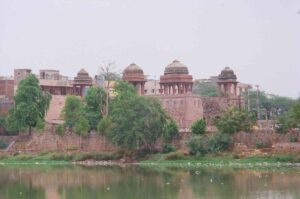 In the heart of Mehrauli, South Delhi, an ancient reservoir is finding new life. Hauz-i-Shamsi, built in 1230 CE by Sultan Shamsuddin Iltutmish of the Delhi Sultanate, has been restored by local residents, turning this forgotten water body into a natural climate buffer and a sanctuary for birds.
In the heart of Mehrauli, South Delhi, an ancient reservoir is finding new life. Hauz-i-Shamsi, built in 1230 CE by Sultan Shamsuddin Iltutmish of the Delhi Sultanate, has been restored by local residents, turning this forgotten water body into a natural climate buffer and a sanctuary for birds.
For years, this medieval lake near Jahaz Mahal stood neglected filled with garbage, choked by weeds, and fed by dirty wastewater. Residents like Zaida Zehra, who moved to the area 18 years ago, remember the frustration of seeing the lake become a mosquito-infested drain. “We felt helpless watching our beautiful talab die,” she said.
But change began in 2023 when the Archaeological Survey of India (ASI) partnered with SEEDS India, a non-profit working on ecological solutions. Together with Mehrauli’s residents, they launched a major restoration project. Community members formed the “Pride of Shamsi” group, led by locals like Zaida, to take care of the lake.
Today, Hauz-i-Shamsi spans five acres with clean water, solar-powered aerators, and floating bio-islands planted with reeds that naturally filter the water. The lake’s edges are fenced and protected, and migratory birds have started returning. Children also play a role Zaida’s daughters and other young residents hold weekend awareness activities like drawing contests and street plays to promote care for the lake.
Restoration wasn’t easy. Wastewater flow into the lake had to be stopped, invasive plants removed by hand (as machines are banned on this heritage site), and the water quality improved using bioremediation methods. Six solar aerators now circulate the water, improving oxygen levels to support aquatic life.
Urban planners and experts say such restored lakes are critical as cities heat up due to climate change. Water bodies like Hauz-i-Shamsi can cool nearby areas by up to 2-4 degrees Celsius, providing natural relief from extreme temperatures.
Delhi has 893 recorded water bodies, but many are neglected or encroached upon. The city’s Heat Action Plan 2024-25 mentions restoring these as part of its climate strategy, but detailed steps are still awaited.
Experts stress that a network of smaller urban lakes like Hauz-i-Shamsi works better than large reservoirs to lower city temperatures. Treated wastewater could also keep these lakes full, a method already used in Bengaluru, where 27 lakes receive treated sewage to stay alive and cool their surroundings.
For Mehrauli’s residents, the revived lake is more than just water it’s a shared success story. “When the sun rises and its light dances on the lake, it feels magical again,” smiles Zaida.
